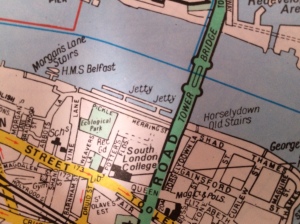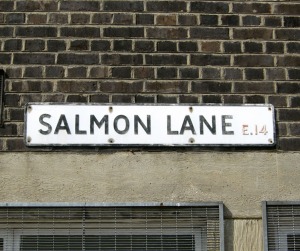
‘Why not fish?’ Paxview enquired of me, making reference to Shadwell. Why not indeed? I hadn’t made the Shadwell – or Shad Thames – connection with fish before, but once the fishy idea was in my head it was like an earworm, so I rushed off to my favourite culinary street name resource, streatsoflondon.
Borrowing heavily (with prior permission, of course) from that site, I can give you the following: Albacore Crescent, Bream Street, Brill Place, Coley Street, Dace Road, Drum Street, Grayling Road, Ling Road, Mullet Gardens, Perch Street, Pike Close, Roach Road, Salmon Place, Shad Thames, Sturgeon Road, Tench Street, Trout Road, and Whiting Avenue.
And, if we’re not being purist about fish rather than seafood, we can also include Oyster Row and streets that are precluded from inclusion on that website, such as Bream’s Buildings, Fish Street Hill and Pickle Herring Street, more of which shortly, but – as is my wont – let’s start on a bit of a tangent with Billingsgate, originally one of the old water gates of the City of London.
That doesn’t have a fishy name but is certainly loaded with fish associations. According to John Stow, the market was originally a general market for a number of goods including corn, coal, iron, wine, salt, pottery – and fish, and by the 16th century had become a specialist fish market. The cries of the vendors gave their name to an expression of vulgar language, as in swearing like a fishwife, particularly a Billingsgate fishwife.
 Near to Billingsgate is Fish Street Hill, once New Fish Street, the main road leading to London Bridge. In the 13th century it became the centre for fishmongers who settled there because of its proximity to the main fish market of Billingsgate; the street was one of the authorized spots for retail fish sales. Samuel Pepys mentions it in his description of the Great Fire of 1666:
Near to Billingsgate is Fish Street Hill, once New Fish Street, the main road leading to London Bridge. In the 13th century it became the centre for fishmongers who settled there because of its proximity to the main fish market of Billingsgate; the street was one of the authorized spots for retail fish sales. Samuel Pepys mentions it in his description of the Great Fire of 1666:
“By and by Jane comes and tells me that she hears that above 300 houses have been burned down tonight by the fire we saw, and that it was now burning down all Fishstreet by London Bridge.”
We’ve touched on Pickle Herring Street, before; this, sadly, no longer exists, having given way to modern developments in the Tooley Street area. The name could be because the street was on the site of one of the Thames River’s old wharves – where cargoes of pickled herrings were shipped.
 On the other hand, the name may also have come from the fact that Sir John Falstofe, who gave his name to Shakespeare’s Falstaff – and was once a fish merchant – lived on this spot in 1447. Incidentally, though herrings were pickled in England as far back as the 14th century, it was more of a Dutch speciality. There is a record, in 1584, of a ‘Peter Van Duraunte alias Pickell Heringe’ being buried in Bermondsey; he was actually a brewer, but he may have had an inn called the Pickled Herring.
On the other hand, the name may also have come from the fact that Sir John Falstofe, who gave his name to Shakespeare’s Falstaff – and was once a fish merchant – lived on this spot in 1447. Incidentally, though herrings were pickled in England as far back as the 14th century, it was more of a Dutch speciality. There is a record, in 1584, of a ‘Peter Van Duraunte alias Pickell Heringe’ being buried in Bermondsey; he was actually a brewer, but he may have had an inn called the Pickled Herring.
As you can see in the map section pictured left, Pickle Herring Street led into Shad Thames under the Tower Bridge Road, so we can stop being tangential and lead into Shad Thames ourselves.
 And, surprise, surprise, the name is nothing to do with fish. It is, instead, probably a contraction of St John at Thames; the Priory of St John at Jerusalem owned about 25 acres of land here from the 13th century until the Dissolution. In Oliver Twist, Bill Sikes lived and died on Jacob’s Island, east of Shad Thames.
And, surprise, surprise, the name is nothing to do with fish. It is, instead, probably a contraction of St John at Thames; the Priory of St John at Jerusalem owned about 25 acres of land here from the 13th century until the Dissolution. In Oliver Twist, Bill Sikes lived and died on Jacob’s Island, east of Shad Thames.
(Incidentally, while I am singing the praises of other blogs such as Paxview and streatsoflondon, and we are on the subject of Charles Dickens, you could do worse than have a look at another great London-related blog, David Perdue’s Charles Dickens Page.)
On to another fish name that has nothing to do with fish: Salmon Lane in Limehouse. This takes is name from the church of St Dunstan’s in Stepney. Work that one out. No, don’t bother, I’ll tell you: ‘Salmon’ in this instance is a corruption of ‘sermon’; this was the closest church for Limehouse residents until 1729 when St Anne’s church was built in Newell Street. So the lane was the route people would walk to church to hear a sermon.

See? Easy when you know. Incidentally, the church of St Anne’s was designed by Nicholas Hawksmoor, contemporary of Sir Christopher Wren; he also contributed to the design of St Paul’s Cathedral and Blenheim Palace.
While I’m not sure about Bream Street, Bream’s Buildings, which leads off Chancery Lane, was once a cul-de-sac. In 1877 it was extended into Fetter Lane; it may have been named after the landowner or builder. The name itself may come from the word ‘breme’ meaning fierce or energetic. Likewise, Coley Street is named for a person rather than a fish: Henry Coley was a 17th-century astrologer and mathematician. That name comes from ‘colig’, meaning dark or swarthy.
Back, briefly to Shadwell – the reason for this entire blog. When I was first in the UK there was a TV comic program called ‘Naked Video’ and one of the regular characters was geeky Welsh Siadwell (pronounced Shadwell). I thought it was one of the funniest things I’d ever seen even though, as a recent arrival to these shores, I understood very few of the references. Does anyone else remember Siadwell? I seem to recall that he was always being threatened with a kicking by the school bully.
About Me (and my Obsession)

My obsession with London street names began in the early 90s when I worked in the Smithfield area and happened upon Bleeding Heart Yard. In my wanderings around London, I kept adding to my store of weird and wonderful street names. Eventually it was time to share – hence my blog. I hope you enjoy these names as much as I do.
– Elizabeth
Recent Posts
- London’s lost rivers: Hanging Sword Alley, Crane Court, and Wine Office Court
- Fox and Knot: murder and pub signs in London street names
- Poultry and Hen and Chickens Court – names for National Poultry Day
- Greenberry Street and Red Lion Square: street names for St Patrick’s Day and Red Nose Day
- Bleeding Heart Yard: revisiting (and debunking) old favourites

4 responses to “London’s fishy streets: from Fish Street Hll to Shad Thames”
I remember ‘Naked Video’ very well. It gave rise to the character of Rab C. Nesbitt (Gregor Fisher) that still endures. Elaine Smith was very sexy (to me) at the time, and Helen Lederer was perfect as the air-head posh girl. Shadwell was played by john Sparkes, who now narrates Peppa Pig, I believe. Here’s a clip of him from the old days, giving one of his monologues.
My only fishy street connection today, is that I once lived with a woman (for a short time) in an unattractive small flat off Salmon Lane. Limehouse was not that nice back then. (1973)
Best wishes, Pete.
I did love all the Naked Video characters. Yes, Helen Lederer was great and I only recently read of the Siadwell/Pepoa Pig connection. Glad to hear you have yet another connection with the streets in my blog!
[…] Pickle Herring Street, in the Tooley Street area, no longer exists, alas, but it supposedly took its name from the fact that the street was on the site of one of the Thames’ old wharves – where cargoes of pickled herrings were shipped. The name may also have come from the fact that Sir John Falstofe – who gave his name to Shakespeare’s Falstaff – lived on this spot in 1447. Falstofe was once a fish merchant, so it could have been his pickled herrings that gave the street its name. […]
[…] (it’s a kind of fish, and there was a fish-related streets post a while ago; you can read it here) is named for a person rather than a fish: Henry Coley was a 17th-century astrologer and […]